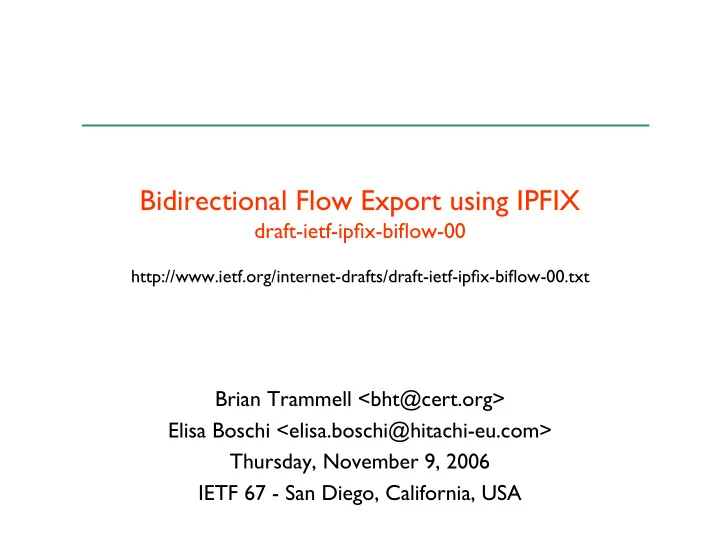

Bidirectional Flow Export using IPFIX draft-ietf-ipfix-biflow-00 http://www.ietf.org/internet-drafts/draft-ietf-ipfix-biflow-00.txt Brian Trammell <bht@cert.org> Elisa Boschi <elisa.boschi@hitachi-eu.com> Thursday, November 9, 2006 IETF 67 - San Diego, California, USA
Motivation • Bidirectional flow information useful for a variety of use cases. • Biflow matching becomes more efficient closer to the measurement interface, and often best addressed at the Metering Process itself. • Need an efficient way to export this data using IPFIX. November 9, 2006 IETF 67 - San Diego 2
Single Record Biflows • Represent each bidirectional flow with a single record. • Define “forward” direction as packets sent from the flow initiator. • Define “reverse” direction as packets sent to the flow initiator. • Assign direction to biflows using a variety of methods, according to application. • Define new “reverse” information elements to represent values for reverse direction. November 9, 2006 IETF 67 - San Diego 3
Reverse PEN • Allocate an IANA private enterprise number (PEN) to the draft. e=0 octetTotalCount = 85 length = 4 e=1 reverseOctetTotalCount = 85 length = 4 reverse PEN = TBA • Information elements within this PEN IE number space correspond to the IETF number space, except that they apply to the reverse direction of a biflow. November 9, 2006 IETF 67 - San Diego 4
Direction Assignment • The largest remaining open issue: how to determine the “source” and the “destination” of a biflow. • Previous revisions of this draft suggested direction be assigned according to Metering Process’ best effort to determine the initiator (sender of the first packet) of the Biflow. • This approach is not applicable in all cases. November 9, 2006 IETF 67 - San Diego 5
Direction Assignment Methods (1) • By Initiator: “source” is source of packet initiating the communication (active open for TCP). – Assume the first packet seen is the first packet sent. – Validate through use of TCP flags, application protocol analysis (e.g. UDP DNS answer count), etc. – Requires synchronization of clocks among Metering Processes. • By Interface/Address: “source” and “destination” assigned via membership in address set or side of a given interface. – Useful when defining a perimeter. – Does not require clock synchronization. – Not appropriate for applications where initiator is important. November 9, 2006 IETF 67 - San Diego 6
Direction Assignment Methods (2) • Random: “source” and “destination” assigned randomly. – The only additional information provided by biflow export is that two flows are related. – Places no restrictions on measurement system arrangement. • Each of these are applicable to certain use cases, and will be selected by the draft as appropriate. November 9, 2006 IETF 67 - San Diego 7
Local Network Metering • Metering Process attached to a shared link layer (shared medium or switch span port) • SHOULD assign direction by initiator. A B MP November 9, 2006 IETF 67 - San Diego 8
Perimeter Metering • Attach Metering Process(es) to links at an enterprise/AS perimeter. • SHOULD assign direction by perimeter – MAY assign by initiator if knowing the initiator is important AND clocks synchronized among MPs. enterprise R A network MP November 9, 2006 IETF 67 - San Diego 9
Metering within Transit AS • Direction assignment by initiator difficult due to clock synchronization issues. • Direction assignment by interface troublesome because addresses may move from one side to another of an MP during IGP/EGP updates. • MAY assign direction randomly. R C MP November 9, 2006 IETF 67 - San Diego 10
From Montréal to Prague • ietf -00 (30 August 2006) – selected reverse PEN allocation policy – began to address direction selection • ietf -01 (November 2006) – addresses remaining open issues with direction assignment as outlined herein. – will continue to incorporate WG comments. November 9, 2006 IETF 67 - San Diego 11
Questions and Discussion November 9, 2006 IETF 67 - San Diego 12
Recommend
More recommend